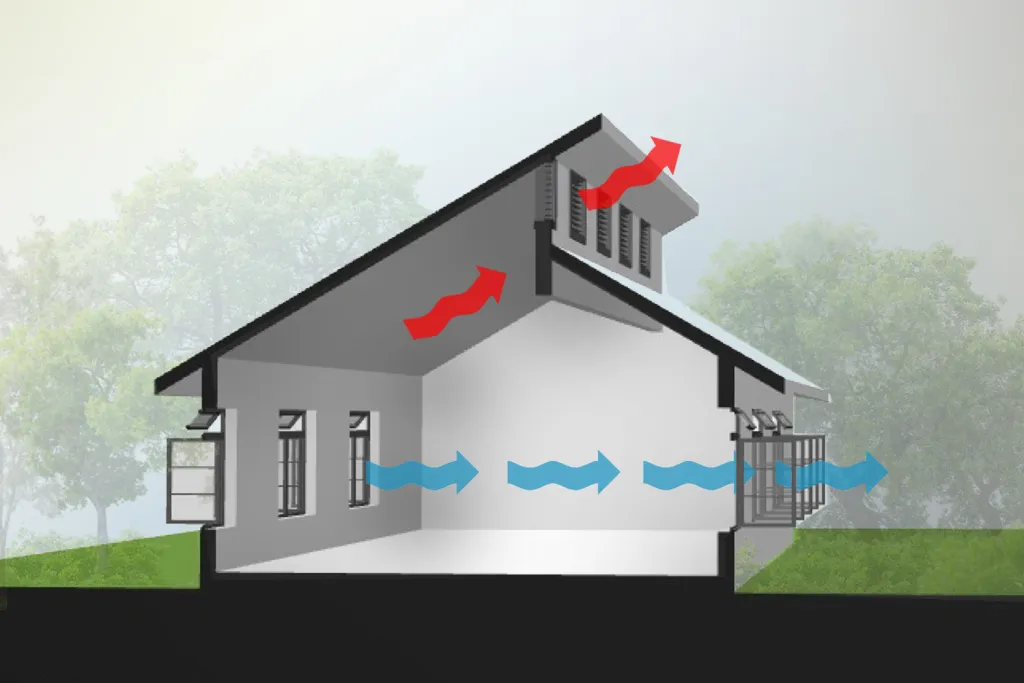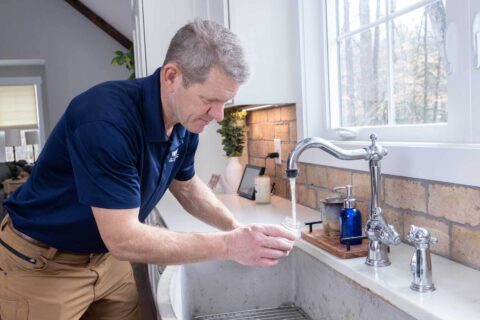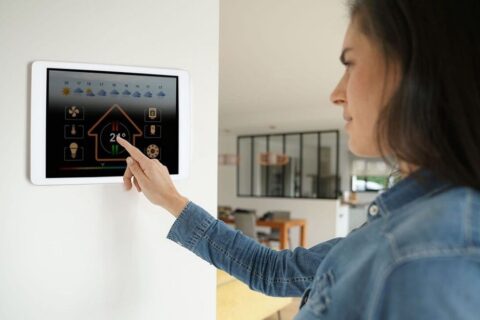Air Balancing: Your Comprehensive Guide to Home Air Flow Techniques
Key Takeaways
-
Air balancing helps promote energy efficiency and HVAC system performance by ensuring even distribution of conditioned air, all of which improve indoor comfort. It’s a critical part of the installation process and regular maintenance.
-
Signs of unbalanced airflow include uneven room temperatures, weak or no airflow from vents, increased energy bills, and excessive dust accumulation. Monitoring these can catch problems before they require a major repair or replacement.
-
To balance airflow at home, adjust vent dampers, clean or replace filters, seal ductwork leaks, rearrange furniture blocking vents, and test adjustments for optimal results.
-
Anemometers, smart thermostats, and HVAC zoning systems are just a few tools that help create the perfect air balance and improve efficiency as a whole.
-
Persistent airflow problems, complex HVAC systems, or the need for advanced equipment warrant professional assistance to ensure proper system functionality.
-
Routine HVAC inspections and keeping vents and filters clean are important aspects of preventative maintenance. This method is vital in keeping air balance and prolonging the life of your HVAC equipment.
To get a comfortable, energy-efficient living space, you need to realize that it all begins with air moving through your home. Your guide to home air balancing techniques is a quick and easy look at how to make your indoor airflow and temperature uniform and comfortable.
Using air balancing techniques like adjusting vents, dampers, and fans, you can even things out and improve your overall HVAC system’s performance. Correct air balancing will improve your home’s comfort.
Not only does air balancing enhance comfort, but it can lower energy bills too by delivering the correct amount of air to each room. Whether dealing with uneven temperatures or aiming for better air quality, this guide provides simple steps and tips to optimize your home’s ventilation.
With the right techniques, a balanced home air environment is a healthier, more comfortable, energy efficient home for your family.
What Is Air Balancing
Air balancing is the process of adjusting HVAC systems to ensure an even distribution of conditioned air throughout a home. This configuration ensures that every room receives exactly the right level of warm or chilled air. In turn, you get the benefit of a reliable, efficient, and comfortable indoor space.
Technicians use tools such as thermometers, airflow meters, and manometers to accurately measure the system’s performance. Then, they adjust it to make sure all parts of the home are heated or cooled the same. It’s not simply a one-time process—it’s the key to keeping your HVAC system running efficiently and effectively for years to come.
The goal of air balancing is to improve comfort, that’s the key reason why it’s so important. Just picture being able to walk from your living room to your bedroom and not notice a huge change in temperature. Homes with good air circulation accomplish this beautifully.
In addition, proper air balancing improves indoor air quality, as it helps to maintain proper airflow. This increase in ventilation dramatically decreases the chance of mold development, the Environmental Protection Agency (EPA) confirms. Balancing increases a building’s energy efficiency, decreasing monthly utility costs and avoiding excess wear and tear on the HVAC system.
This balancing process should not only happen during new installations but be regularly revisited as well. A pre-season tune-up can help you identify persistent problems, like uneven cooling or heating. This proactive measure avoids expensive system failures, increases your system’s longevity, and helps maintain lower energy consumption.
Balanced airflow is just as important to achieve stable temperatures in the entire home. Without it, one room might be too humid or chilly while another is perfectly comfortable. When air is distributed as it should be, you’re not fiddling with the thermostat all the time, meaning you’re using less energy.
In turn, this reduces utility bills and saves taxpayer dollars in the long run. An HVAC system that is poorly balanced must work double time to make up for inconsistent airflow. This additional stress can cause the system to have a shorter life cycle and a higher chance of costly repairs.
With proper air balancing, the issues above never arise, protecting equipment from excessive wear and tear. It maximizes the effectiveness of heating and cooling systems to make sure they’re performing the way you expect them to.
Beyond comfort and cost savings, air balancing promotes a healthier living experience. Properly balanced air flow helps prevent the buildup of moisture that can cause mold. Mold is more than an inconvenience; it’s associated with deadly diseases such as lung cancer and emphysema.
By correcting negative and positive airflow issues with air balancing, you can eliminate these dangers and hazards, while enhancing the air quality in your house. It all begins with measuring airflow in your home. Technicians use tools such as anemometers and hoods to see how much air is flowing through each vent.
They examine the ductwork to get an idea of how it’s laid out and if it’s causing any issues with airflow distribution. Bending ductwork or having leaks in your ducts can throw off airflow which will cause different temperatures in your home.
Adjusting dampers is another critical step. Dampers are adjustable devices inside the ductwork that regulate the amount of conditioned air that goes to each room. Through proper adjustments, technicians can control airflow to the most critical areas.
For example, if one room is consistently warmer than others, dampers can help direct more cool air to that area. Air pressure on the outside matters too. Pressure differences between rooms may create unpredictable air flow.
Air balancing makes sure that the pressure is equal throughout your home, giving you more even distribution of temperature. Certified air balance services typically involve corrections for improved energy efficiency, like sealing duct leaks or component upgrades.
Benefits of Home Air Balancing
Improve Energy Efficiency
Properly balanced airflow is critical to lowering energy use. Since your HVAC system is distributing air evenly, it doesn’t have to work extra hard to heat or cool particular zones. This efficiency translates directly into lower energy bills, with many homeowners saving an average of 30%.
For example, a home where air balancing has been performed will require less use of the furnace or air conditioner, with more even temperatures throughout. Beyond the dollars saved, using less energy shrinks your carbon footprint, helping the planet in the process.
An energy-efficient home can increase property value, too, since buyers are increasingly looking for homes that reduce utility costs and support their sustainable lifestyles.
Enhance Indoor Comfort
A properly balanced system makes sure that every room in your home stays the same comfortable temperature. With proper airflow, there are no hot or cold spots, ensuring homes are warm in the winter and cool in the summer.
That consistency improves life at home, as you won’t be forced to experience the annoyance of drafts or hot and cold spots. Research indicates that comfortable indoor environments contribute to mental well-being, in part by alleviating the stress that accompanies discomfort.
Improved HVAC performance produces comfort, which makes your house feel more welcoming.
Prolong HVAC System Lifespan
Preventative strain on HVAC components is inevitable without regular air balancing. This is easier on the equipment, leading to a longer lifespan of the system and postponing costly replacements.
Repair saving money systems that are running efficiently need fewer repairs, saving money in the long-term. Regular preventative care like this keeps your HVAC running like a well-oiled machine for years to come.
Signs of Unbalanced Air Flow
Uneven Room Temperatures
Drafty rooms or hot rooms can create a jarring experience when moving from a chilly room to a hot room due to unbalanced air flow. In many cases, these temperature variations exceed 2 to 3 °F. This can be aggravating, especially if one room feels ice cold while another feels like a sauna.
Some common causes of the issue include poor duct design. What’s more, vents frequently end up in terrible places, such as under windows that receive direct sunlight. This can turn 76% of that light into heat. Monitoring temperature variations between levels or spaces in your home can help identify trouble spots before they become more serious issues.
Weak or No Airflow from Vents
Weak airflow, or an absence of airflow altogether, are indicators that something’s gone wrong with the system. Vents will sometimes have dampers—knobs that adjust the louvers—that are jammed up or set to the closed position.
Air flow problems often happen at registers at the end of HVAC runs. These vents are often placed in baseboards, walls, or floors. A good test is to stick your hand in front of the air or listen for whistling noises as you move vent dampers. If a single vent is still not working, cleaning or rebalancing it can restore airflow.
Increased Energy Bills
Unbalanced air flow forces HVAC systems to work overtime, adding stress and increasing energy bills. For example, air conditioning units need to offset heat from solar radiation that comes in through windows.
By tracking energy usage, these problems can be identified early on, which can save money in the long run.
Excessive Dust Accumulation
Inadequate airflow in the existing HVAC system increases dust accumulation, creating a negative effect on air quality. With regular HVAC maintenance and quick identification of unbalanced airflows, spaces can be healthier and cleaner.
Steps to Detect Air Flow Issues
Check Air Vent Performance
Ensure that you’re getting the appropriate airflow from each of your home’s vents. Go room by room and count the number of vents per room, then write down the quality of airflow coming out of each vent. If you experience weak airflow or no airflow at all, this may indicate a blockage or restriction.
Blockages can be due to the placement of furniture, debris in ducts, or dampers being closed. Change settings on the vent, like opening louvers in areas with low airflow to help increase circulation. Making it a habit to check vents for blockages will ensure air can flow freely throughout your home.
For larger spaces, keep in mind that larger rooms usually require higher airflow than smaller spaces. With the ability to balance airflow by room size, you’re offering an enhanced level of comfort and consistency.
Inspect Air Filters and Ducts
Clean air filters are an important part of maximizing HVAC performance. Dirty filters can restrict airflow, making your system work harder while increasing your energy bill. Changing out filters regularly not only means a more efficient system, but can cut bills 5–15%.
In addition, check all ductwork for leaks or other visible damage. Leaky ducts can lead to very uneven airflow, sometimes making rooms stuffy and other times too cold. By fixing these issues, air flows freely like it was designed to.
Use a Thermometer for Testing
A simple thermometer can go a long way in helping you identify temperature imbalances throughout your home. Take readings in multiple rooms, from each floor where possible, and make note of large differences.
For example, if one room seems to be warmer all the time, it could be a sign of bad airflow. Look for discrepancies between readings to spot any air flow issue. If you have a multi-story home, set upstairs and downstairs thermostats at least 2°F different from each other for more even cooling.
When testing is done accurately, improvements can be targeted and focused.
Observe Pressure Imbalances
These pressure imbalances can create costly airflow and comfort inefficiencies. Detect air flow problems by checking for drafts around registers or exterior doors. Negative pressure causes outdoor air to be drawn into the space, and positive pressure excludes outdoor air.
Both can cause uncomfortable hot and cold spots and wasted energy. Fixing these imbalances by sealing leakage or balancing the vents re-establishes this equilibrium and makes people more comfortable.
How to Balance Air Flow at Home
1. Adjust Vent Dampers
Vent dampers are essential to ensuring that the right amount of air is flowing to each room. By opening dampers to rooms with less airflow, you will start to get the return circulation you need, while increasing comfort.
For rooms that are too chilly, partially shut the dampers, letting less conditioned air into those rooms. One of the biggest things is seasonal calibration—such as opening dampers more in the summertime to allow cooling.
Regular inspections will help damper operation stay in check and help to maintain a balanced HVAC system year-round. Making small adjustments to vents in your home will allow you to fine-tune your comfort level without making large, uncomfortable changes.
2. Clean or Replace Air Filters
Dirty air filters can greatly affect airflow and cause your HVAC system to be overworked and underperforming. Clean filters keep air moving efficiently, making your home more comfortable and saving you energy dollars.
It is advisable to change filters every 1-3 months based on usage. Replacing dirty filters will maximize airflow, and maintain clean indoor air, creating a more comfortable and healthier home.
3. Seal Leaks in Ductwork
Another typical culprit of uneven air flow, leaks in ductwork can throw off your entire system. Check ducts for holes or gaps and seal them with foil tape or mastic sealant.
Sealing ducts properly can make your home more energy efficient, saving you an average of 42% on your utility bills. For large leaks, bringing in a pro will make sure the gaps are all well sealed.
4. Rearrange Furniture Blocking Vents
Furniture set above or in front of vents can obstruct airflow, throwing off their circulation. Consider furniture and room layouts to make sure vents aren’t blocked.
Keep clear paths between furniture to allow air to flow freely, and review furniture layout regularly to ensure you’re optimizing airflow.
5. Test and Repeat Adjustments
Once you make changes, pay attention to how comfortable you are during the day and night. Make sure to document any changes and give the HVAC system a few days to a week or more to see the results.
Patience will be needed in order to realize a truly balanced system. Regular testing helps keep your home healthy and comfortable all year long.

Tools and Devices for Air Balancing
Essential Tools for Air Balancing
To achieve a balanced HVAC system at home, a few essential tools can simplify the process:
-
Anemometer: Measures airflow rates precisely, helping you identify uneven air distribution at vents.
-
Provides precise temperature control by learning from real-time data, maximizing comfort and energy savings.
-
HVAC Zoning Systems: Tailors air distribution by dividing the home into zones, addressing specific heating and cooling needs.
Each tool is crucial in diagnosing and remedying air balancing challenges, getting your home operating at maximum efficiency.
Use an Anemometer
An anemometer measures airflow velocity, and displays it in a unit of measure known as cubic feet per minute (CFM), the main metric used while air balancing. Simply point the tool at vents to determine if air is properly circulating.
For example, if one room has much less airflow measured, the system may need to be adjusted to ensure good comfort in all areas. With these readings, you can plan in-system modifications, such as dampers or insulation upgrades, to achieve a well-balanced system.
Install Smart Thermostats
Smart thermostats can improve HVAC performance, as they learn your routine and automatically program the thermostat to save energy while you’re away. They save energy by preventing waste, all while keeping the air inside buildings comfortable and healthy.
For example, allowing separate schedules for weekdays and weekends helps save energy. Their unique ability to monitor and adapt increases efficiency and maintains perfect air balance 100% of the time.
Utilize HVAC Zoning Systems
HVAC zoning utilizes dampers to control airflow to certain areas of the home, which is beneficial for larger or multi-level homes. For instance, zoning offers the ability to effectively cool a sun-exposed upstairs bedroom without overcooling other, more shaded parts of the house.
By catering to specific requirements, zoning minimizes system strain and helps maintain even airflow.
When to Call a Professional
Persistent Air Flow Problems
Sometimes, airflow problems just won’t go away no matter how much you’ve done the standard troubleshooting steps. These warning signs could signal deeper problems with your HVAC system. You may be dealing with blockages or leaks in the ducts, the wrong damper settings, or potentially equipment issues.
Ignoring these symptoms will leave you with a home plagued by hot and cold spots. This can result in increased energy bills and even permanent damage to your system. For example, if certain vents consistently receive little to no airflow, despite open dampers, it’s time to call in an expert.
Documenting these issues—such as significant temperature variation or uneven airflow—can assist professionals in quickly pinpointing the issue’s root cause and providing a targeted solution.
Complex HVAC System Issues
Modern HVAC systems frequently have multi-zone systems, older components, or complex controls that demand specialized expertise. If your home has multiple zones for heating and cooling, experts can help you create a plan. They can address complex distribution challenges, particularly if you’re working with an old system.
Their knowledge guarantees even airflow distribution, energy efficiency and longer system life. The National Comfort Institute suggests that you receive a professional air balancing service on an annual basis. This helps ensure that your home is always the perfect temperature.
This simple, regular practice can help address these inequities. It means no more 2-3°F warmer/cooler rooms than the others with the pivotal impact on comfort that entails.
Need for Advanced Equipment
Other projects require specialized tools that are not available at your average weekend warrior DIYers home. Professionals use precise equipment such as anemometers, thermal cameras, and manometers that measure airflow and pressure accurately.
These tools are a great way to identify specific problems, such as dampers that are not calibrated properly or leaky ducts. Even with DIY solutions, without these advanced tools, most fixes will miss the most critical problems, resulting in continuing inefficiencies.
With professional expertise come professional adjustments, better air quality, and better energy savings. A pre-season air balance service can get your system tuned up and ready for the summer months of heavy use. It increases its longevity and performance.
Preventative Maintenance Tips
Schedule Regular HVAC Inspections
Frequent, routine HVAC inspections will help your residential HVAC system run more efficiently and enable you to recognize system issues before they escalate into disasters. Scheduling these inspections early on uncovers potential air balancing issues, such as uneven airflow, before they become a costly complaint. This proactive approach prevents problems like air leaks in the ductwork from turning into expensive repairs.
A licensed professional HVAC technician can assist you in determining the best balance of airflow and efficiency across your system, ensuring your home remains comfortable and maintains a consistent temperature throughout the year. For instance, if leaks are found in the ductwork, sealing them can prevent the HVAC unit from overworking to keep the temperature steady.
Creating a maintenance schedule, whether monthly, quarterly, or yearly, ensures you are proactive rather than reactive with your HVAC maintenance. Regular inspections can significantly prolong your system’s life and save you money on energy bills by identifying inefficiencies before they become costly problems.
Keep Vents and Filters Clean
Clean vents and filters are the first step to proper airflow. Dust and debris build up in the filters as time goes on. This creates more stress on the HVAC unit, causing increased wear and tear and increased energy expenses.
Regularly cleaning or replacing air filters every 1 to 3 months, on average, can save you from these problems. A dirty filter, for instance, can immediately choke off airflow by over 50 percent, driving down efficiency. Ensuring vents aren’t blocked by furniture or dust buildup allows for a more balanced air flow.
Being proactive with cleanliness means investing in your HVAC system’s wellness, which saves money on maintenance costs and energy bills.
Monitor System Performance
Establishing a baseline and tracking system performance over time will allow you to spot negative trends and prevent future inefficiencies. For instance, if some rooms are always too hot or too cold, it could be a sign of airflow imbalance.
Advanced building monitoring can proactively identify things like increasing energy consumption over time, which usually indicates some form of inefficiency or need for maintenance. Many homeowners use smart thermostats or energy trackers to collect data, helping them make informed decisions about adjustments or repairs.
Keeping yourself aware will help keep your system running at peak efficiency, giving you the most comfort for the least cost.
Conclusion
Getting your home’s air perfectly balanced makes all the difference in the world. It helps make each of their rooms comfortable while saving energy. By identifying airflow issues early and taking some straightforward measures, you can set yourself up for a system that operates at peak performance. Closing off unused rooms, sealing ductwork leaks, and using smart air balancing tools can make a tremendous difference.
Preventive maintenance
Regular inspections and routine repairs further stave off bigger problems down the line.
When the process seems overwhelming and the outcome uncertain, call in a pro. Most importantly, they’ll make sure the job is done safely and correctly. Their experience can help you fine-tune your system for optimal performance.
Tip 2 – Begin with the basics and make it a habit. That’s the secret to truly lasting comfort and efficiency. Whether it’s easy, efficient airflow or even temperature, take control of your home’s airflow and experience the comfort that an air balanced, properly maintained home can provide.
Frequently Asked Questions
What is air balancing?
Air balancing is the act of properly adjusting your HVAC unit to provide uniform airflows throughout your home. This is key to optimizing comfort, energy efficiency, and the performance of your residential HVAC system.
Why is home air balancing important?
More energy efficiencyLower energy costsNo more hot or cold spotsGreater comfortLonger HVAC service life
It’s the key to balanced, even indoor comfort, room to room.
How do I know if my home has unbalanced airflow?
Signs that you may have unbalanced airflow in your residential HVAC system include inconsistent temperatures throughout your home, low airflow from your registers, and an increase in your energy costs. You might find certain rooms to be too stuffy or too drafty due to improper duct work.
Can I balance air flow at home myself?
Well, now you can! Often simple home improvement steps such as adjusting vent dampers, cleaning air filters, or sealing duct leaks in your existing HVAC system are needed to balance airflow. When in doubt or faced with a major problem, seek the advice of a qualified HVAC contractor.
What tools are needed for air balancing?
The most basic setup requires a simple thermometer, an anemometer, and some duct tape. To ensure proper HVAC maintenance and achieve accurate airflow readings, you may want to purchase a digital airflow meter or hire a professional HVAC technician.
When should I call an HVAC professional?
Call a professional HVAC technician if airflow issues persist after basic fixes or if you suspect major duct work, insulation, or HVAC unit problems. They have cutting-edge tools to pinpoint the diagnosis with precision.
How can I prevent future airflow imbalances?
Change air filters regularly, look for leaks in the duct work, and schedule annual HVAC maintenance to ensure your residential HVAC system operates efficiently and maximizes airflow.


